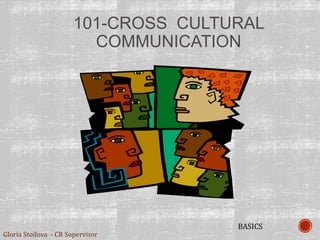
101-Cross cultural communication
- 1. 101-CROSS CULTURAL COMMUNICATION Gloria Stoilova - CR Supervisor BASICS
- 2. the way of life of a people passed down from one generation to the next through LEARNING. Cross-cultural communication is a field of study that looks at how people from different cultural backgrounds communicate, in similar and different ways among themselves, and how they Endeavour to communicate across cultures. Intercultural communication is a related field of study. Gloria Stoilova - CR Supervisor
- 3. Why Cross Culture Communication is important ? ◦ Business Opportunities ◦ Job Opportunities ◦ Improves the contribution of employees in a diverse workforce ◦ Sharing of views and ideas ◦ Talent improvisation ◦ An understanding of diverse market Globalization: Cross border movement of people, goods and data brings more and more cultures into contact with one another and increases the potential of cross culture communication. Gloria Stoilova - CR Supervisor
- 4. CULTURAL BARRIERS Language: Language is one of the most obvious cultural barriers. Differences in language can render two human beings completely incapable of talking to one another. anxiety: We live in a culturally diverse world. People will encounter individuals from different races, religions, and nationalities in their day to day encounters. There is often anxiety surrounding unfamiliar cultures. Gloria Stoilova - CR Supervisor
- 5. ONE OF THE MAJOR BARRIERS TO EFFECTIVE CROSS-CULTURAL COMMUNICATION IS THE LACK OF UNDERSTANDING THAT IS FREQUENTLY PRESENT BETWEEN PEOPLE FROM DIVERSE BACKGROUNDS. AS THEY MAY HAVE DIFFERENT VALUES, BELIEFS, METHODS OF REASONING, COMMUNICATION STYLES, WORK STYLES, AND PERSONALITY TYPES, COMMUNICATION DIFFICULTIES WILL OFTEN OCCUR. Lack of understanding: Gloria Stoilova - CR Supervisor
- 6. IMPROVING INTERCULTURAL COMMUNICATION Slow Down Even when English is the common language in a cross cultural situation, this does not mean you should speak at normal speed. Slow down, speak clearly and ensure your pronunciation is intelligible. Separate Questions Try not to ask double questions such as, "Do you want to carry on or shall we stop here?" In a cross cultural situation only the first or second question may have been comprehended. Let your listener answer one question at a time. Gloria Stoilova - CR Supervisor
- 7. AVOID NEGATIVE QUESTIONS Many cross cultural communication misunderstandings have been caused by the use of negative questions and answers. In English we answer 'yes' if the answer is affirmative and 'no' if it is negative. In other cultures a 'yes' or 'no' may only be indicating whether the questioner is right or wrong. For example, the response to "Are you not coming?" may be 'yes', meaning 'Yes, I am not coming.‘ Gloria Stoilova - CR Supervisor
- 8. OBSERVATION It is always best to observe the behaviors of the group and follow their lead. Gloria Stoilova - CR Supervisor
- 9. In low-context cultures, such as in academic communities, communication is mostly verbal and written. Very little information is this culture is communicate nonverbally. Watch out for your gestures – they can make people to accept you faster, BUT not properly used they can (and will) put you in great troubles. Nonverbal Communication Gloria Stoilova - CR Supervisor
- 10. MEANINGS OF HAND GESTURES IN DIFFERENT CULTURES. The well known O.K. sign… can put you in troubles at different parts of the Globe – lets see…. USA= OK JAPAN=MONEY. RUSSIA=ZERO TURKEY/VENEZUELA (South America) = HOMOSEXUAL. BRAZIL/ITALY = INSULT (=middle finger=swearing) ARAB COUNTRIES = YOU WILL SEE!!! Lets not to be so trouble oriented? Unified signs in DIVING = I am good, are you? BUT misused under water again CAN and WILL put you into troubles. Gloria Stoilova - CR Supervisor
- 11. BASICS RULES: Avoid use of complicated technical phrases, jargon, and acronyms. Explain the meaning of technical language and acronyms throughout your conversation or mail. Listen to others - Ask questions - There are two basic types of questions: Open and Closed: Closed questions are those that can be answered by either “yes” or “no” or with a specific bit of data. Open questions, however, encourage people to talk. Gloria Stoilova - CR Supervisor
- 12. Gloria Stoilova - CR Supervisor We will continue to learn about effective communication in a separate workshop.
